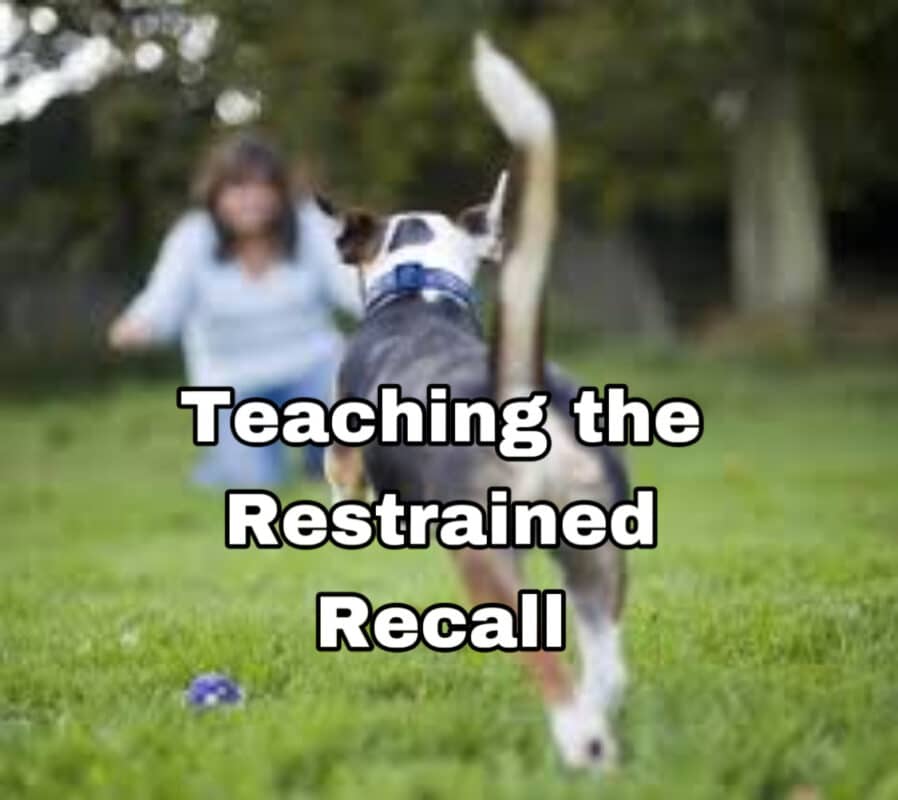Dog Commands, Dog Training and Behavio, Obedience Training, Pet Guardianship
Mastering the Restrained Recall: Essential Training Guide for Your Dog’s Safety
Posted on by Dog Behaviorist
Unlocking the Secrets of Dog Restrained Recall Training: A Step-by-Step Guide to Teaching Your Dog to Come When Called
By Will Bangura, M.S. CDBC, CBCC-KA, CPDT-KA, FFCP, (Dog Behaviorist), Certified Dog Behavior ConsultantIntroduction
Imagine you’re at a park, and amidst the laughter of children and the gentle rustle of leaves, there’s a bond of trust and joy unfolding between a pet guardian and their dog. This bond is often nurtured through various training exercises, one of which is the restrained recall. A restrained recall isn’t just a party trick; it’s an essential component of dog safety and obedience. This training method not only encourages your dog to come to you when called, even amidst distractions, but it also adds an element of fun and urgency to the exercise, making it more engaging for the dog. It uses the principle of positive reinforcement, rewarding the dog for a correct response, which increases the likelihood of the behavior being repeated. This article will guide you through the process of teaching a restrained recall. This task, though simple in concept, requires patience, understanding of dog behavior, and a little bit of teamwork. By the end of this guide, even those with no prior knowledge of dog training will be able to foster this crucial skill in their canine companions.Part 1: Understanding the Basics
Foundational Knowledge:
Recall is the ability of a dog to return to their guardian when called, no matter the situation. This command is arguably one of the most important for a dog to learn, not only for their safety but also for the peace of mind of their guardian. It allows for off-leash play and is vital in preventing dangerous situations. To begin, it’s important to understand that dogs do not come pre-programmed to understand human language. Dogs learn through association and repetition, with positive reinforcement marking the behaviors we desire. This means when a dog responds correctly to a command and is rewarded, the behavior is more likely to be repeated (Smith, 2020). Preparation for Training: To start, you will need a few things:- Treats: Have a variety of high-value treats that your dog finds irresistible.
- Leash: A standard leash to ensure control and safety during initial training stages.
- A Helper: Another person who the dog likes and feels comfortable with.
Part 2: Setting the Stage for Restrained Recall
Establishing a Starting Routine:
Firstly, gain your dog’s attention in a calm environment. Use their name and look for signs of focus on you—eye contact is a good indicator. Start by engaging your dog with gentle play or affection to create a positive atmosphere. Decide on your recall cue, which can be a word or a whistle, but it should be something distinct that you can use consistently.The Role of the Helper:
Choosing the right helper is key. This person should be someone your dog already knows and trusts. The helper’s job will be to hold the dog gently by the collar or harness without causing discomfort or resistance. Their demeanor should be calm and encouraging, not threatening or overly exciting, which could cause the dog to become too aroused. The helper will stand with the dog while you, the pet guardian, move a short distance away—start with just a few feet to keep it simple.Part 3: The Restrained Recall Process
Step-by-Step Guide:
- Holding the Dog: The helper holds the dog by the collar or harness, speaking to them in a gentle voice to keep them calm.
- Gaining Attention: You will then get the dog’s attention by using their name and showing them their favorite treat or toy.
- The Recall Cue: Give the recall command with enthusiasm and a clear, upbeat tone. The excitement in your voice is crucial; it should say, “Something great is about to happen!”
- The Release: Upon your cue, the helper will release the dog, allowing them to come to you.
- The Reward: As soon as the dog reaches you, immediately give them the treat and lots of praise. The reward must be given promptly to ensure the dog understands what action is being rewarded.
- Repetition and Distance: Repeat these steps, gradually increasing the distance and adding mild distractions as your dog becomes more reliable in their response.
Troubleshooting Common Issues:
Sometimes, a dog may hesitate to leave the helper, or they might become distracted. Patience is key. If the dog is struggling, decrease the distance, lessen distractions, and make sure the rewards are enticing. Always end on a positive note to keep the experience enjoyable for the dog.Part 4: Advanced Training and Generalization
Progressing Difficulty:
As your dog becomes more proficient with the restrained recall, you can begin to add complexity to the training.- Increasing Distance and Distractions: Gradually increase the distance from which you call your dog. Begin in a controlled environment and slowly introduce more distractions, such as the presence of other dogs, new people, or different terrains and locations.
- Incorporating Different Environments: Practice the restrained recall in various settings — parks, fields, or any safe, enclosed outdoor areas. This helps your dog understand that the recall command should be obeyed regardless of the location.
- Training with Varying Levels of Restraint: Experiment with different levels of restraint. This could mean holding the leash loosely or having the helper only touch the dog lightly, preparing the dog for an eventual transition to an off-leash recall.
Phasing Out the Helper:
Once the dog consistently responds to the recall with distractions and at a distance, you can begin to phase out the helper.- Reduced Dependency: Start by having the helper stand near the dog without holding them, then progress to the dog being on a long line that drags on the ground, which you can step on if needed to prevent the dog from ignoring the recall.
- Solo Recall Training: Once the dog responds reliably without being held, practice the recall without the help use a long line for safety if you are not in an enclosed area until you are confident in the dog’s recall reliability. Continue to an enclosed area until you are confident in the dog’s recall reliability.
Part 5: Reinforcing and Maintaining Recall
Ongoing Training and Reinforcement:
To keep the recall strong, you must continue to practice and reinforce the behavior.- Continuous Practice: Regular training sessions are crucial. Integrate recall into daily activities, such as calling your dog for meal times or before a walk.
- Varying Rewards: Use different types of rewards to maintain your dog’s interest. Along with treats, use toys, praise, or play—whatever motivates your dog the most. Sometimes, the reward can be the release to go back to play after coming to you.
- Incorporating Recall into Daily Routines: Use everyday situations to practice recall. Call your dog to you during walks, before giving them freedom in a dog-safe area, or as part of play sessions.
Common Mistakes to Avoid:
- Inconsistency in Cues or Rewards: Always use the same cue for recall and vary the rewards unpredictably to keep your dog guessing and eager to respond.
- Neglecting to Practice in Different Environments: Recall must be proofed in various settings to ensure your dog understands the command is universal.
- Over-Reliance on Treats: While treats are a powerful motivator, they should not be the only reward your dog receives for responding to a recall. Affection, play, and other life rewards are equally important to create a well-rounded and reliable recall.
Conclusion
The restrained recall is more than just an obedience exercise; it is a fun and interactive way to strengthen the bond between you and your dog while ensuring their safety. Remember that each dog learns at their own pace. Patience, consistency, and positivity are the cornerstones of effective training. Celebrate every small victory with your dog, and enjoy the process of learning together. Training your dog is a journey that requires dedication, understanding, and a bit of creativity. With these detailed steps, you are well on your way to mastering the restrained recall, setting the foundation for a responsive and happy companion. References For further reading and a deeper understanding of the techniques and practices recommended in this guide, consider exploring the following resources:- Smith, J. A. (2020). “The effectiveness of dog training with positive reinforcement methods.” Journal of Veterinary Behavior.
- Fennell, L. (2003). “The Everything Dog Training and Tricks Book.” Adams Media.
- McConnell, P. (2006). “The Other End of the Leash: Why We Do What We Do Around Dogs.” Ballantine Books.
- Reid, P. J. (1996). “Excel-erated Learning: Explaining in plain English how dogs learn and how best to teach them.” James & Kenneth Publishers.

Facebook
Twitter
LinkedIn

